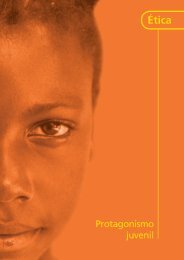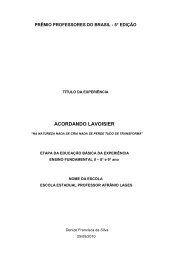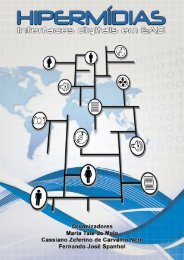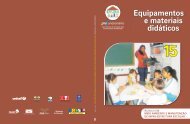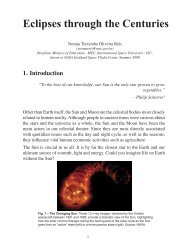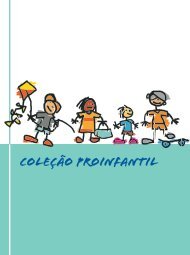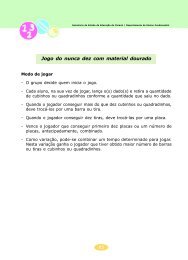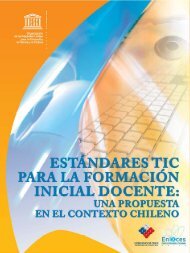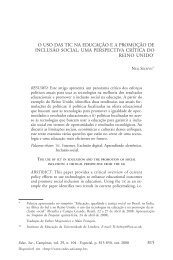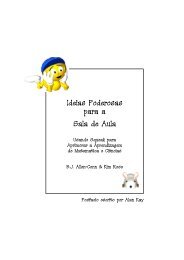BIO-CULTURAL COMMUNITY PROTOCOLS - Portal do Professor
BIO-CULTURAL COMMUNITY PROTOCOLS - Portal do Professor
BIO-CULTURAL COMMUNITY PROTOCOLS - Portal do Professor
Create successful ePaper yourself
Turn your PDF publications into a flip-book with our unique Google optimized e-Paper software.
PART I / CHAPTER 2<br />
4. Lessons Learned and their Importance for IRABS and<br />
the Implementation of Article 8(j)<br />
4.1 Communities<br />
The bio-cultural and legal empowerment that the five<br />
communities engaged with lead to a series of important<br />
points about the implications of IRABS and the<br />
implementation of Article 8(j). As a result of developing a<br />
BCP, the ways in which the communities envisaged their<br />
bio-cultural futures became clearer. The importance of<br />
Article 8(j) is elicited through the analysis of the linkages<br />
between the biodiversity within which ILPCs live, their<br />
livelihoods, their spiritual beliefs and cultural understandings<br />
of nature, and the ways in which their customary rules and<br />
practices promote conservation and sustainable use of<br />
biodiversity. At the same time, witnessing the daily challenges<br />
they face and their general marginalization, especially in the<br />
case of the Samburu and the Raika, highlighted the limitations<br />
of the IRABS. Para<strong>do</strong>xically, the communities are extraordinarily<br />
resilient yet vulnerable to ecological change and the<br />
interference of external forces. Whilst they could benefit from<br />
regulatory frameworks that can guarantee them increased<br />
bio-cultural security, they are also susceptible to being harmed<br />
by well-intentioned but badly implemented laws or ABS deals.<br />
All five communities said they found the BCP process useful for<br />
a number of reasons and felt emboldened to know that their<br />
ways of life are considered important at the international level,<br />
even if the national action required of signatories to the CBD<br />
has not yet been seen at the local level. We draw on some of<br />
the key issues from the above excerpts of the communities’<br />
BCPs to highlight the importance of the development of BCPs<br />
to ILCs in the context of the incumbent IRABS.<br />
First, the communities had neither previously considered<br />
entering into an ABS deal nor thought through the whole range<br />
of associated issues that should be engaged with.<br />
Some, such as the Bushbuckridge traditional healers and<br />
Samburu pastoralists, had been visited by researchers in the<br />
past, but at most felt disgruntled by the lack of feedback they<br />
had received. They did not know that an international regime<br />
is being negotiated or that each of their respective countries<br />
(Kenya, India and South Africa) has <strong>do</strong>mestic bio-prospecting<br />
regulations. There is a striking disparity between the<br />
<strong>BIO</strong>-<strong>CULTURAL</strong> <strong>COMMUNITY</strong> <strong>PROTOCOLS</strong> AS A<br />
<strong>COMMUNITY</strong>-BASED RESPONSE TO THE CBD<br />
importance that their TK and genetic resources is being given<br />
under the international regime and their lack of awareness. It<br />
confirms the need for community-lead processes to highlight<br />
the importance with which the CBD views ILCs’ traditional ways<br />
of life and to explain the rights and remedies available to<br />
affirm them.<br />
Second, each of the communities underscored their<br />
dependence on the local ecosystems for their livelihoods<br />
and explained how their TK is both an outcome of this<br />
relationship and something that allows them to continue their<br />
ways of life. The pastoralists’ ethno-veterinary TK, for example,<br />
is crucial to the survival of the livestock on which their own<br />
lives depend. This issue, reflected by each community in their<br />
respective contexts, underscored the integral nature of TK to<br />
ILCs’ lives. Their TK in this sense has an incalculable worth with<br />
no tangible monetary value because they have never<br />
considered it as a tradable commodity. Working with<br />
communities to appreciate the worth of their TK, indigenous<br />
breeds and plant genetic resources is not new, but we found<br />
that such bio-cultural empowerment is vitally important in<br />
the context of IRABS. This point is amplified when one considers<br />
the different types of TK communities have and the overemphasis<br />
that IRABS is placing on commercially viable<br />
knowledge over knowledge or ecological understanding that<br />
is more important for their ways of life.<br />
Third, because the knowledge holders had received their TK<br />
from ancestors and others in the community, the idea of<br />
selling their TK or providing it to strangers from outside the<br />
community was a highly novel concept. Communities found<br />
it useful to approach new ideas such as the ownership or<br />
transfer of animal genetic resources and TK from the<br />
perspective of customary laws and practices that underpin<br />
the usual community-based sharing of these resources. The<br />
communities also emphasized the need for FPIC before the<br />
use of any of their TK and genetic resources as being a part<br />
of customary law, as opposed to something new that has<br />
emerged from the international negotiations. This interestingly<br />
highlights the fact that each community already has customary<br />
laws and practices relating to the transfer of genetic resources<br />
and TK within their own contexts in order to promote genetic<br />
34




